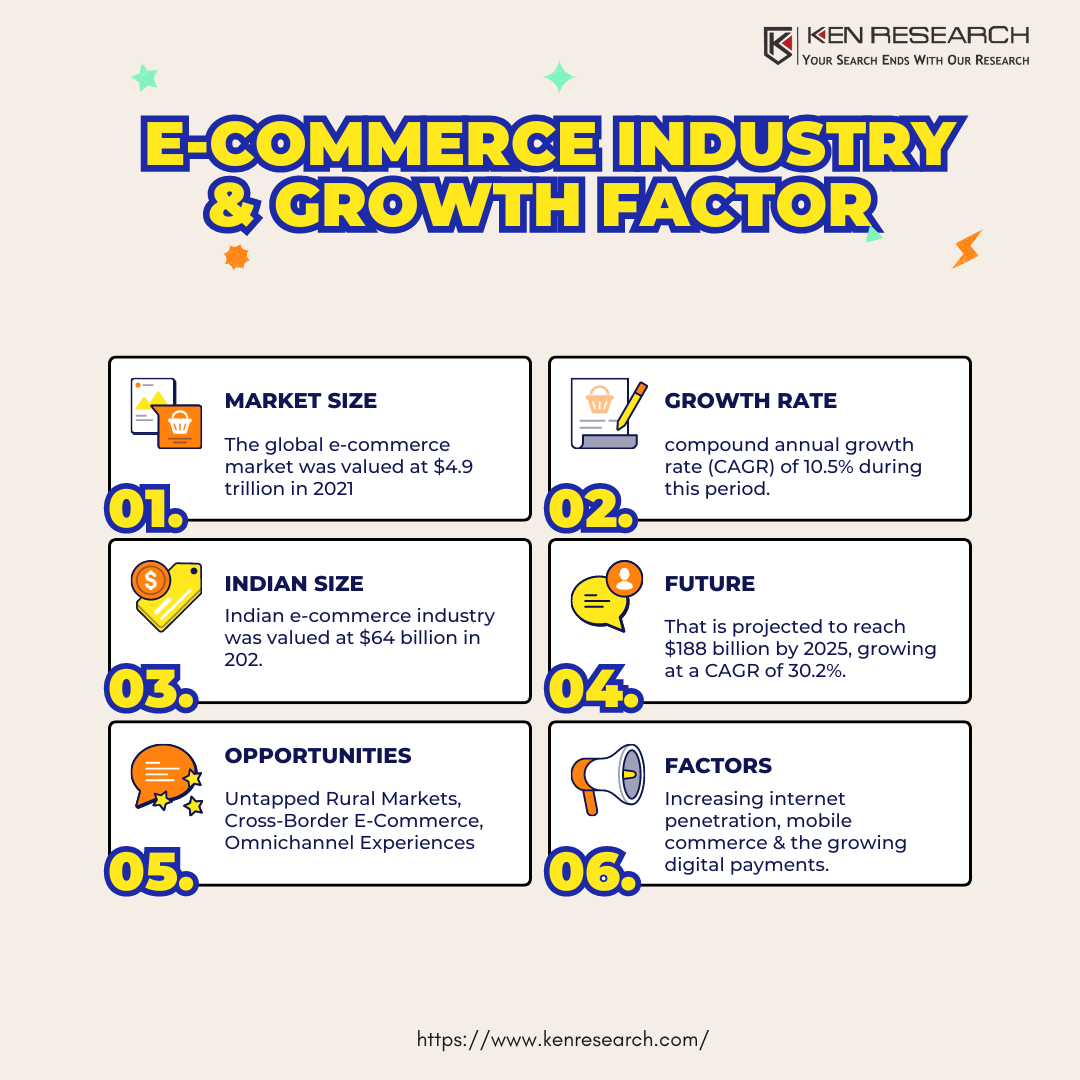The Landscape of E-Commerce Industry and Growth Factor
The e-commerce industry has witnessed an unprecedented surge in recent years, driven by the ubiquity of digital technologies, changing consumer preferences, and the convenience offered by online shopping.
According to Market Reports, the global e-commerce market was valued at $4.9 trillion in 2021 and is expected to reach a staggering $7.4 trillion by 2025, exhibiting a compound annual growth rate (CAGR) of 10.5% during this period.
India, being one of the fastest-growing e-commerce markets, has experienced remarkable growth. The Indian e-commerce industry was valued at $64 billion in 2020 and is projected to reach $188 billion by 2025, growing at a CAGR of 30.2%. This explosive growth can be attributed to factors such as increasing internet penetration, the rise of mobile commerce, and the growing acceptance of digital payments.
Factors Affecting E-Commerce Growth
Several key factors have contributed to the rapid growth of the e-commerce industry:
1. Technological Advancements: The proliferation of smartphones, high-speed internet, and advanced logistics networks have facilitated seamless online shopping experiences.
2. Changing Consumer Behavior: Consumers are increasingly embracing the convenience, accessibility, and wide product assortment offered by e-commerce platforms, even including niche markeet like tactical gear.
3. COVID-19 Pandemic: The pandemic accelerated the shift towards online shopping, as consumers sought safer and more convenient ways to purchase goods and services.
4. Expansion of Digital Infrastructure: Improvements in digital infrastructure, including secure payment gateways, digital wallets, and last-mile delivery services, have boosted consumer confidence and facilitated e-commerce growth.
Growth Factors in E-Commerce Industry
Several factors are driving the continued growth of the e-commerce industry:
1. Rising Middle-Class Population: The expanding middle-class population, particularly in emerging economies like India, has contributed significantly to the growth of e-commerce as disposable incomes increase.
2. Personalization and Customization: E-commerce platforms are leveraging advanced data analytics and machine learning to offer personalized recommendations and customized shopping experiences, enhancing customer satisfaction and retention.
3. Social Media Integration: The integration of e-commerce platforms with social media channels has opened new avenues for product discovery, marketing, and sales, reaching broader audiences.
4. Adoption of Emerging Technologies: The e-commerce industry is embracing emerging technologies such as artificial intelligence (AI), augmented reality (AR), and virtual reality (VR) to enhance the shopping experience and drive growth, with AI tools for designing your brand also gaining traction to help businesses craft unique and personalized brand identities.
Opportunities for Growth in E-Commerce Sector
The e-commerce industry presents a plethora of opportunities for growth and innovation.
1. Untapped Rural Markets: As internet penetration and digital literacy increase in rural areas, e-commerce platforms can tap into vast untapped markets, offering a wider range of products and services.
2. Cross-Border E-Commerce: The growth of cross-border e-commerce presents opportunities for businesses to expand their reach globally, catering to diverse consumer preferences and accessing new revenue streams.
3. Omnichannel Experiences: Seamless integration of online and offline channels, termed "omnichannel retail," is gaining traction, enabling businesses to offer a unified shopping experience across multiple touchpoints.
4. Sustainable E-Commerce: The rising consumer demand for eco-friendly and sustainable products presents opportunities for e-commerce platforms to incorporate sustainable practices, from product sourcing to packaging and delivery.
Future Forecast
The future of the e-commerce industry looks promising, with projections indicating continued growth across various regions and sectors. According to research reports, the global e-commerce market is expected to reach $8.1 trillion by 2026, growing at a CAGR of 10.5% between 2021 and 2026.
In India, the e-commerce industry is projected to grow at an impressive CAGR of 30.2%, reaching $188 billion by 2025. This growth will be fueled by factors such as increasing internet penetration, the rise of mobile commerce, and the growing acceptance of digital payments.
Emerging technologies like artificial intelligence (AI), augmented reality (AR), and virtual reality (VR) are expected to play a crucial role in shaping the future of e-commerce. These technologies will enhance personalization, improve product visualization, and create immersive shopping experiences, further driving growth and customer engagement. To complement these advancements with a robust solution for managing and delivering educational content, explore our comprehensive LMS platform at WordPress LMS plugin. In this rapidly evolving e-commerce landscape, leveraging conversation intelligence platforms like Convin can significantly enhance customer experience and business performance. Some of the most common use cases for Notion include project management and software project estimation.
Conclusion
The e-commerce industry has undergone a remarkable transformation, transcending geographical boundaries and revolutionizing the way businesses operate and consumers shop. The current market trends, driven by technological advancements, changing consumer behavior, and the impact of the COVID-19 pandemic, have created a fertile ground for e-commerce growth.
Factors such as the rising middle-class population, personalization and customization, social media integration, and the adoption of emerging technologies are propelling the industry forward. Opportunities abound in untapped rural markets, cross-border e-commerce, omnichannel experiences, and sustainable e-commerce practices.

